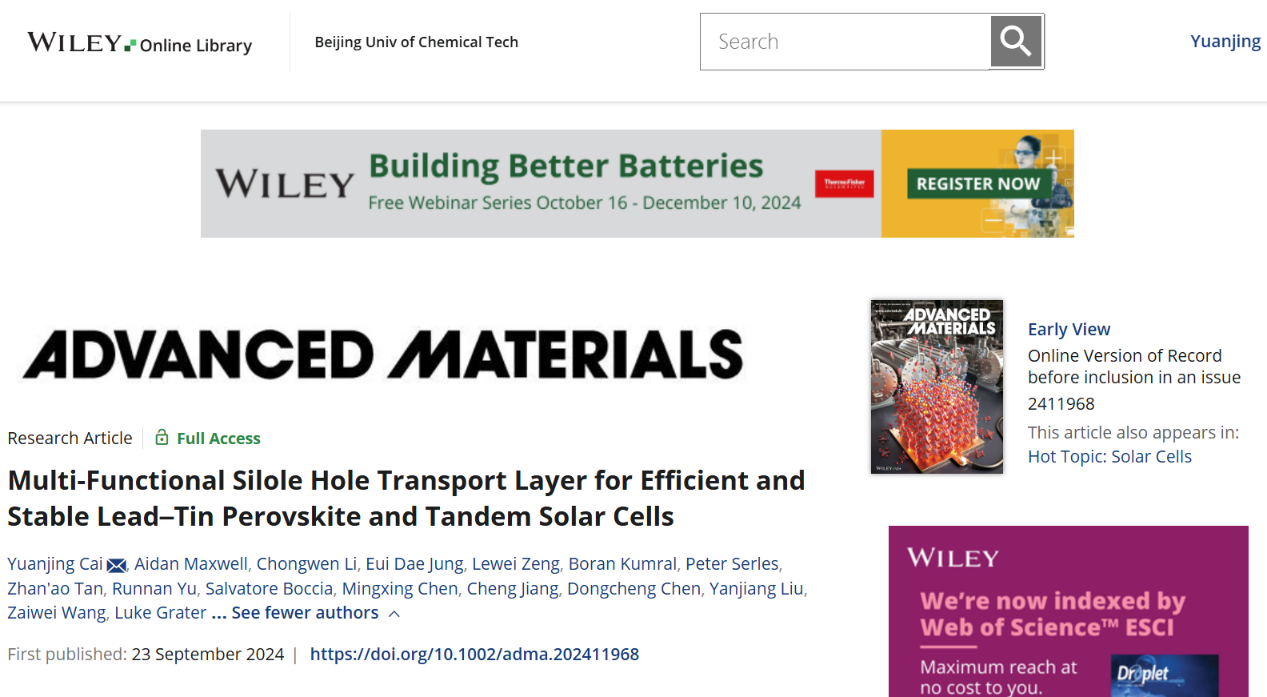
Narrower bandgap perovskites alloyed with tin (Sn) and lead (Pb) can reach bandgaps as low as ~1.2 eV, enabling theoretical power conversion efficiencies (PCEs) higher than 30% in single-junction solar cells and serving as a critical component for realizing PCEs of up to 41% in all-perovskite multijunction solar cells. Despite high theoretical efficiencies and rapid improvements in performance, high-efficiency ~1.2 eV mixed Sn-Pb perovskite solar cells (PSCs) generally rely on poly(3,4-ethylenedioxythiophene) polystyrenesulfonate (PEDOT:PSS) as the hole transport material (HTM); a material that is considered to be a bottleneck for long-term stability due to its acidity and hygroscopic nature.
Recently, Prof. Yuanjing Cai’s group from Beijing Advanced Innovation Center for Soft Matter Science and Engineering at Beijing University of Chemical Technology (BAIC-SM at BUCT) has developed a multifunctional HTM with the structure of carboxyl phenyl group substituted silole. In this special molecular design, silole core enables excellent hole transport, the selectively incorporated carboxyl moiety can not only improve molecular solubility and wettability but also function as an anchoring group which has been shown to form coordination bonds with Pb2+/Sn2+, providing surface passivation and reduced interface energetic losses. Furthermore, Sn-Pb perovskite atop this HTM result in an improved film quality with an enhanced crystallinity, suppressed oxidation of Sn2+ and better morphology with more uniform surface contact potential (Figure 1). Replacement of PEDOT:PSS with this HTM leads to 23.2%-efficient single-junction Sn-Pb PSCs (Figure 2), 25.8%-efficient all-perovskite tandems (Figure 3), and long operating stability in ambient air.

Figure 1.Properties of mixed Sn-Pb perovskites deposited on carboxyl phenyl group functionalized siloleHTM and PEDOT:PSS. a) Schematic structure of -COOH group binding with the surface of Sn-Pb perovskite. b) XRD patterns, c,d)SEM images and e,f) KPFM images of Sn-Pb perovskite films fabricated on different HTM substrates.

Figure 2.Performances of single-junction Sn-Pb narrow-bandgap PSCs based on carboxyl phenyl group functionalized silole HTM and PEDOT: PSS. a) Forward and reverse J-V scans of Sn-Pb narrow-bandgap PSCs. b) Statistics of PV parameters of Sn-Pb narrow-bandgap PSCs (35 devices for each type). c) Stabilized power output efficiency of champion devices. d)EQE spectra of narrow-bandgap Sn-Pb PSCs with the integrated Jsc values indicated. e) Long-term stability of encapsulated Sn-Pb narrow-bandgap PSCs under continuous light illumination (1-sun, multi-colour LED simulator). The maximum power point tracking (MPPT) was carried out under ambient conditions(RT, » 50% RH).

Figure 3.PV performance of all-perovskite tandem solar cells with carboxyl phenyl group functionalized silole HTM in Sn-Pb perovskite subcell. a)Schematic diagram of tandem device structure with a photograph of the substrate after the deposition of interconnection layers Au/ITO. b) Cross-sectional SEM image of all-perovskite tandem solar cell. c) Forward and reverse J-V scans along with the stabilized power output efficiency near the maximum power point (inset).d) Long-term stability of encapsulated tandem device under continuous light illumination (1-sun, white LED simulator). The maximum power point (MPP) tracking was carried out under ambient conditions (25-30°C, »50% RH).
This article entitled “Multi-Functional Silole Hole Transport Layer for Efficient and Stable Lead-Tin Perovskite and Tandem Solar Cells” has been published in Adv. Mater. The first and corresponding author is Prof. Yuanjing Cai from BAIC-SM at BUCT. This work was supported by the National Natural Science Foundation of China, the project of high-end foreign experts from the Ministry of Science and Technology of the People’s Republic of China, and the Beijing Natural Science Foundation.This work was also supported in part by the Ontario Research Fund-Research Excellence program, and the Natural Sciences and Engineering Council of Canada. We thank all the collaborators from University of Toronto, Peking University, South China University of Technology and BUCT for their contributions to this research work.
Article information:
Y. Cai, A. Maxwell, C. Li, E. D. Jung, L. Zeng, B. Kumral, P. Serles, Z. Tan, R. Yu, S. Boccia, M. Chen, C. Jiang, D. Chen, Y. Liu, Z. Wang, L. Grater, Multi-Functional Silole Hole Transport Layer for Efficient and Stable Lead-Tin Perovskite and Tandem Solar Cells, Adv. Mater. 2024, DOI: 10.1002/adma.202411968.
Article link:
https://onlinelibrary.wiley.com/doi/10.1002/adma.202411968